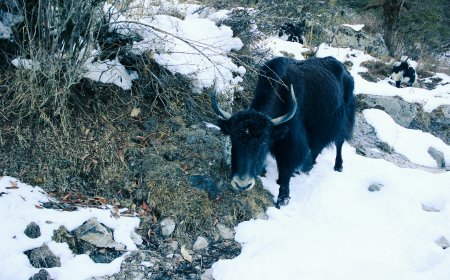How to Overcome Altitude on Annapurna Using Proven Tips
Trek the Annapurna Circuit for epic mountain views, rich culture, and adventure through Nepal’s most iconic landscapes.

Trekking in theAnnapurna Base Camp region means you'll be going up to some seriously high places where the air gets thin, and it might be hard to breathe. This can lead to altitude sickness, which is something you need to be careful about. Luckily, there are a few straightforward tips to help you enjoy this amazing mountain experience without too much trouble.
First up, take your time when climbing. Your body needs a bit to get used to the thinner air. Look for plans that include rest days, especially before and after tackling high spots like Thorong La (5,416m). Don't rush, and pay attention to how you're feeling. Make sure to drink a lot of water. Staying hydrated is key, since being dehydrated can make altitude sickness worse. Try to steer clear of too much alcohol or caffeine, since those can dry you out . Eat a good amount of carbs to keep your energy up. A balanced diet will help your body manage the stress of the altitude and keep you fueled for long days on the train.Get plenty of rest each day and dont push yourself too hard. Your body needs time to recover from the effort of climbing. At night, keep warm and cozy since the cold can add to the strain. Talk to your doctor about medications like Acetazolamide (Diamox). It can help you get used to the altitude faster and ease symptoms, but it shouldnt replace a steady climbing pace. Take deep, slow breaths to help get more oxygen and calm any nerves, as anxiety can make altitude issues worse.Lastly, if you start feeling bad with symptoms like severe headaches, nausea, dizziness, or trouble breathing, be ready to head down right away. Catching issues early is really important. By pacing yourself, staying hydrated and well-fed, resting enough, and listening to your body, you can handle the challenges of high altitudes and take in the stunning views of Annapurnas trails. Being prepared and aware will help make your trek safe and enjoyable.
What You Should Know About Altitude Sickness
Altitude sickness, also known as Acute Mountain Sickness (AMS), happens when your body struggles with the lack of oxygen in high altitudes. You might feel headaches, nausea, dizziness, and fatigue. In serious cases, it can lead to life-threatening conditions like HAPE or HACE. Its important to know about these risks before you head out on the Annapurna trail, which climbs over 5,000 meters. Being aware of how altitude can affect you will help you spot symptoms early and take the right steps to stay safe and enjoy your trek.
Take Your Time to Get Used to the Altitude
Getting used to the altitude is key to avoiding sickness. Don't rush your ascent; let your body adjust to the thinning air. A good rule is to climb high, sleep low, which means gaining elevation during the day but coming back down to sleep. Make sure to take rest days, especially before and after big climbs like Thorong La. Approach altitude gain gradually so your body can produce more red blood cells, which helps you breathe better and lowers your risk of getting sick.
Drink Plenty of Water
Staying hydrated is super important at high altitudes because dehydration can make you feel worse. Aim to drink at least 3 to 4 liters of water a day, even if you're not thirsty. If youre using natural water, be sure to purify it to avoid getting sick. Limit your caffeine intake since it can dehydrate you. Drinking enough water helps your blood flow better and improves oxygen delivery, making it easier to cope with the thinner air. Keep an eye on the color of your urineclear or light yellow means youre well-hydrated. Pair good hydration with rest and food for a better trekking experience.
Eat Well for Energy
Eating properly helps keep your energy up and aids in adjusting to the altitude. Focus on carbs for quick energy since theyre easier to digest when youre up high. Include proteins and healthy fats for lasting energy. Stay away from heavy, greasy foods that can upset your stomach. Opt for smaller meals throughout the day to keep your energy steady, and add in some fruits and veggies for nutrients. Good nutrition will boost your stamina and help your body deal with the trek's demands.
Skip the Alcohol and Smoking
Avoiding alcohol and smoking while youre at high elevations is a smart move. Alcohol can dehydrate you and hurt your breathing, which can worsen altitude sickness symptoms. Smoking cuts down on the oxygen in your blood, making you feel worse. Both habits can drain your energy and cloud your judgment. To stay safe and comfortable during your Annapurna trek, its best to steer clear of these habits while youre up high.
Keep an Eye on Your Symptoms
Be on the lookout for signs of altitude sickness, especially after quick ascents. Pay attention to headaches, dizziness, nausea, and breathlessness. If you have a pulse oximeter, use it to check your oxygen levels. Dont just assume youre tired; listen to your body. Catching symptoms early lets you take action, like resting, drinking water, or heading back down. Trekking with friends can help, as you can watch out for each other. Staying aware is really important to avoid mild symptoms turning into serious health issues.
Consider Medication When Needed
Medications like Acetazolamide (Diamox) can help with altitude sickness and speed up how quickly you acclimate. Talk to a doctor before your trek to learn about the right dosage and side effects. Pain relievers and anti-nausea drugs can help with symptoms, but they shouldnt be your only plan if you start feeling unwell. Make sure to carry a well-stocked medical kit. Remember, while medications can help, theyre most effective when combined with gradual climbing, hydration, and rest.
Plan Your Rest Days Wisely
Make sure to include rest days in your trip schedule. These days, help your body adjust to the altitude and recover from any hard work youve done. Plan them after your big altitude gains or before tough climbs. Use this time to hydrate, eat well, and take short walks at lower altitudes. Avoid doing anything strenuous on these days to get the full benefit of resting. A good plan for rest can help you prevent altitude sickness and recover quicker.
Take it Slow and Dont Push Yourself Too Hard.
Going up slowly means youre less likely to get altitude sickness. Dont rush to cover too much ground or climb too fast. Keep a steady pace and take breaks when you need them. Pushing too hard can make your symptoms worse. If you start feeling bad, dont hesitate to rest or go back down if necessary. A slow and steady trip helps your body adjust and keeps you in good shape to enjoy the trek.
Know When to Go Down
If altitude sickness symptoms get worse or you start feeling severe effects like confusion, chest tightness, or shortness of breath, it's time to head down. Delaying can lead to really serious conditions like HAPE or HACE. Quick action and medical care are important if things get bad. Always put your safety first, even if that means not reaching the summit. Being ready to turn around can be lifesaving and ensures you'll be able to hike another day.
What's the best way to handle high altitude?
The best approach is to take your time acclimatizing. Gradually go up in elevation to help your body get used to less oxygen. Stick to the climb high, sleep low methodclimb up during the day, but rest at lower altitudes at night. Keep yourself hydrated, eat healthy meals, and steer clear of alcohol and smoking. Watch for signs of altitude sickness and take breaks if you need to. Medications like Acetazolamide can be useful, but they should go hand in hand with acclimatization. If things get worse, its important to head back down quickly for your safety.
How can I avoid altitude sickness in Nepal?
To dodge altitude sickness in Nepal, go up slowly and plan some acclimatization days, especially on treks like Annapurna and Everest. Drink plenty of water and eat a carb-rich diet. Avoid alcohol and smoking while trekking. Be aware of early signs like headaches or dizziness, and take them seriously. If your doctor suggests it, you can use medications like Diamox. Get enough rest and dont push yourself too hard. Choose a good trekking plan that allows for proper acclimatization. If the symptoms get worse, go back down and seek medical help.
How do I prevent altitude sickness while trekking?
Prevent altitude sickness by taking it easy and allowing time for your body to acclimate. Don't rush your ascenttry to raise your sleeping elevation by no more than 300 to 500 meters a day. Drink lots of water and eat small, frequent meals loaded with carbs. Stay away from alcohol and smoking since they can make things worse. Pay attention to how you feel and take breaks if you start feeling unwell. Medications like Acetazolamide might help, but check with your doctor first. Always be ready to go back down if you start feeling bad.
How can I adjust to altitude quickly?
You can adjust to altitude quickly by going up slowly and adding rest days at mid-elevations to help your body adapt. Stay hydrated and eat foods rich in carbs for energy. Avoid alcohol, smoking, and tough activities at the start Trek to Annapurna base camp. If a doctor prescribes Diamox, it can help with breathing and getting enough oxygen. Try breathing exercises to build lung capacity. Sleep at lower altitudes than where you reached during the day. Keep an eye on your symptoms to find the right pace for yourself. Being patient and planning will help you acclimate faster and safely.




































